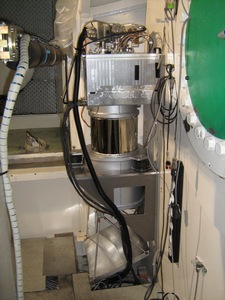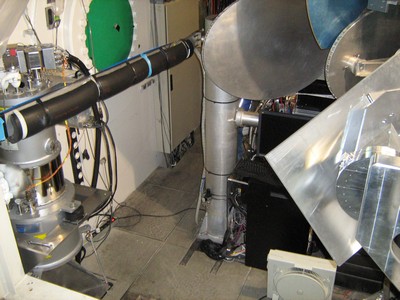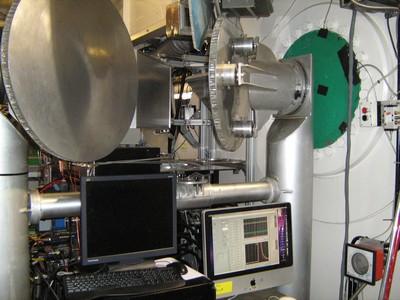GISMO run #6 (April 2012, 1st pool run)
Staffing
- GSFC: J. Staguhn, A. Kovacs, S. Maher, E. Sharp (1st week), D. Fixsen (first 4 days), D.Benford (last 5 days)
- IRAM: S. Leclercq (1st week), A. Sievers (1st week AoD), D. John, J. Abreu (2nd week AoD), IRAM Granada staff
- Other observers: A. Karim (1st week), A.Edge (2nd week)
Schedule: 05.04. - 21.04.2012
IRAM 30m schedule page: http://www.iram.fr/IRAMFR/PV/sche/12/s15v1.html
GISMO log: https://mrt-lx1.iram.es/Devices/GISMO/ (internal)
Summarized schedule of the run:
Dates |
Main event |
Thursday 05/04 - Monday 09/04 |
Arrival of ES, SM and DF at the telescope with missing hardware, mount GISMO, cool down |
Tuesday 10/04 - Tuesday 17/04 |
Arrival of JS, AK, SL, and AK at the telescope, alignment, calibration/characterization work (see test plan), pooled projects observations, departure DF, ES |
Tuesday 17/04 - Tuesday 24/04 |
Departure SL AK, arrival DB AE, pooled projects observations |
GISMO final version
Same 8x16 pixels as 2nd to 5th test runs, working at 2mm (the –3dB window is 140-162 GHz), with an individual pixel size = 0.9 Fλ.
Same special features from previous runs: 2 motorized neutral density filters, controllable shutter, automated observing procedures usable via a dedicated GUI (see observer's manual), CRUSH reduction package.
- New updates: cold baffle, final position in the receiver cabin with corresponding warm optics (M5, M6), new cold pupil.
Daily reports
Thursday 05/04 - Monday 09/04
ES, DF and IRAM staff mounted and cooled down GISMO at its final position (see pictures below). Everything looks fine, based temperature reached, nice response of the detectors, first light on Saturn shows a nice shape indicating the optics is fine.
Tuesday 10/04
JS, AK, AK, SL, AS at the telescope. Alignment with laser (SN anf DJ). Everything looks fine, but weather is bad.
Here's some pictures of GISMO installed in the 30m receiver cabin:



Mid afternoon: abnormal temperature rise on the detector package. Maybe a little touch somewhere, vibrations transmission ... investigation underway. Weather 100% humid anyway.
Wednesday 11/04
The cryogenic problem we experienced yesterday afternoon occurred after a helium transfer, but it's only several 10s of minutes latter that we saw the detector package start a slow and constant rise of temperature. The 2 main hypothesis were : a touch (something moved or broke) or a leak which didn't have an immediate effect because the charcoal in the cryostat was absorbing the incoming helium until it reached a saturation point. After several tests (eg moving filters) and brainstorming we pumped on the vacuum of the cryostat and noticed there was indeed gas in it, latter on we recycled the sorbtion fridges (3He and 4He) which had the effect to warm up all the detector package environment above 4K, while pumping on the vacuum. Then everything went back to normal and to base temperature. So we think the problem was maybe an o-ring that froze during the He transfer, and once it reached 4K during the recycling it "defroze" and went back into place. Everything went very fine during the night, first data processing shows we are surely below 10 mJy*s^0.5 ! Check the GISMO log link above to see observed sources list and pre-processed maps. First we looked at Mars for pointing / focus / flux calibration / first NEFD estimations / beam maps, then check responses on fainter sources such as quasars, and since everything was nice and weather good, had a first glimpse at an extended source looking at the galactic center, then back on a fainter planet: Neptune. All observations are on the test project for now; we'll start the science pool once we are perfectly characterized and calibrated.
At mid-morning we checked again focus and started a pointing session. Unfortunately after only 2 pointing sources we lost the data preprocessing feedback, and we saw the detector package starting to increase again in temperature. We decided to recycle again while figuring out what was going on with the data. We confirm the presence of a tiny leak; another hypothesis for it is the entrance window which is very thin and might be subject to some kind of capillarity leak. It seems we will have to recycle more often than anticipated, but beside that it shouldn't be much a problem. In the meantime we figured out that the missing data problem was due to an IDL license temporally lost; we recovered the data; ready to resume the pointing session once we are back to base temperature.
Thursday 12/04
The pointing session went fine. At 18:15 UT (11/04) we started science observations (LockSWM1). The weather and GISMO being nice an stable, and the calibration fine, at 23:20 UT we went for a first try on a deep integration (HDF). Unfortunately the bad weather arrived at 4:00 UT (12/04). Though degrading, the opacity stayed at levels that are OK for 2mm observations, however its fluctuations generated an unmanageable skynoise. We had to stop the observations.
At 8:00 UT the weather is still badly fluctuating, and the forecast is pretty pessimistic. We noticed that the detector package started to rise again; it seems that the time span between the rises increases. Another hypothesis is that there' maybe no leak but gas trapped in the cryostat (e.g. superinsulation) that we didn't purged completely previously. Since we can't observe due to weather, we are trying a drastic measure: evaporating all the 4He reservoir to let the cryostat cold stages warm up to 20K, then we will pump on it to get rid of the residual gas, and then cool down again.
Detectors back to base temperature and ready for observation at the end of the day... But bad weather all day long and night.
In the meantime, doing analysis of what we observed so far we found out that the pointing model used by the telescope was not the EMIR pointing model as we though but something much worse. It turned out that the telescope control system software badly interpreted as the first parameter of the model a comment that had had been introduced in the parameter file. Hopefully thanks to the pointing observations on bright references we did before each science observation Attila has been able with CRUSH to recover from this bad pointing model situation. Nevertheless the pointing session we did yesterday is mainly useless...
Friday 13/04
Bad weather: no observation.
